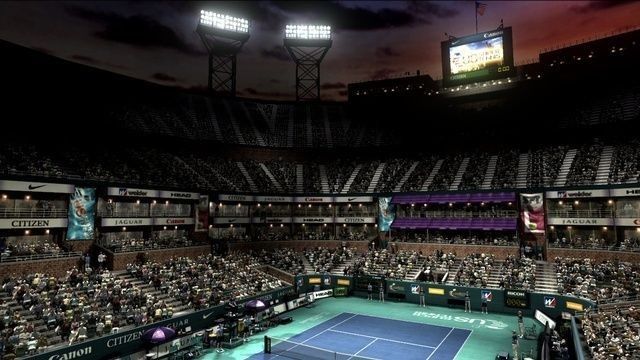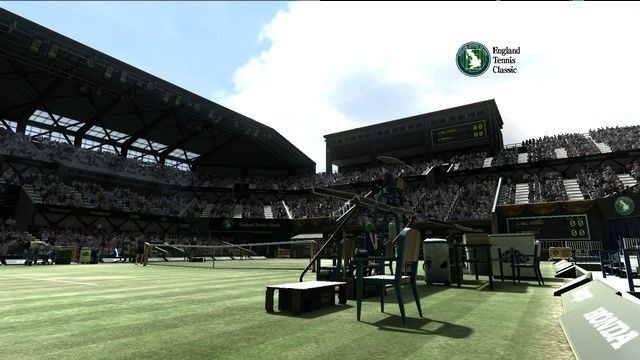Indeed, viewing the in-game action, you’d be hard pushed to know whether this was a game of Virtua Tennis 4, 2009 or even 3, at a stretch. The roster of athletes, texturing and lighting effects are basically the same, and whilst the level of polish is high this time around, it was hardly lacking in that respect previously. In terms of animation things remain convincing and responsive, but taken in direct comparison to Top Spin 4 it’s clear that Sega’s engine is due a significant overhaul. There’s none of the weight and organic feel that 2K’s excellent animation system manages to produce, and a handful of new missed-shot sequences do little to add to the core experience.
 |
| Visually it remains indistinguishable from the 2009 version |
Whilst it would be true to say that the Virtua Tennis approach doesn’t necessarily require the introduction of realistic physics and the breadth of animation required to approach such a simulation, its arcade leanings would certainly benefit from more than a cursory rehash for older players. What we get this time round is the introduction of the ‘Power Shot’ - which is a slow-motion nearly-unbeatable winner, triggered using B on the Xbox controller once a suitable gauge has been filled with rally strokes that conform to the playing style of your character.
In practice it’s a neat system and makes you wonder what else could be introduced to spice up proceedings without breaking accessibility beyond repair. Power Shots add a moment of dramatic tension as the camera swoops around your player before they smash the ball to your chosen location, and they also introduce a small element of tactics, enabling lesser players to break the stride of a dominating opponent, and the fact they can be returned - albeit with great difficulty - gives the opposition a sliver of hope. The only criticism is that it’s sometimes difficult to get a grip of your on-court position during the Michael Bay style swooping and circling, but nevertheless it’s a feature that sits well with the core attitude of the series.
The career mode has also been tweaked and re-arranged, although perhaps not quite as wholesale as you may have wished. The World Tour is now structured into a board game that sees you exchanging movement tickets to land on specific tiles that correspond to mini-games, rest, publicity, management and tournaments, with the overall aim to rack up enough star points and cash to ensure qualification for major events and unlock playing styles and outfits. It’s an interesting take on the formula, but ultimately only serves to remove a layer of control as to how you develop your pro, eventually frustrating more than it does entertain.
 |
| The US represents the final stage of the career mode |
The mini-games that make up for the brunt of that career mode progression (and also party mode elsewhere), are - as is tradition - a mixed bag of fairly brilliant and fairly dull. Highlights include learning to serve by aiming through a wall of football defenders past a moving goalkeeper into an empty net, whilst the new chicken run activity takes the frenetic collectathon of the fruit conveyor and injects an element of danger in the form of a trail of chicks that can be crushed by oncoming bouncing balls. Poker, Wind Farm and Pass-the-Bomb are all passable, but probably not ones you’ll ever want to come back to outside of those initial sessions.
Elsewhere, unsurprisingly, things remain the same. Arcade mode is a familiar small tournament-based sequence that offers up the traditional format; exhibition mode is as it says on the tin; whilst online support again lurches between highly entertaining and suffering from ruinous lag. Matchmaking and tournaments function as well you’d expect, but sports fanatics should be aware that none of the more established custom features from other games have made the cut here. If you want a league against your friends or in-depth stat tracking, you’d better pick up a pen and paper.
 |
| Grass remains the most challenging surface |
For everybody else though, lest we forget, Virtua Tennis 4 is by all accounts a fantastic introduction to the series, and a suitable alternative for anybody put off by the realism of the competition. The core arcade playability of the match engine remains in tact and as entertaining as ever, with a learning curve measured in minutes rather than hours. It’s a good game in singleplayer or multiplayer, and there are many rivalries between both human and AI opposition that have the capacity to turn anybody into air-punching shrieking maniacs for those all-important few seconds of triumph. But then the same could be said of 2009 and even Virtua Tennis 3, at a fraction of the cost.
Not a bad game then by any stretch, but hopefully the last small iteration before Sega’s inaugural next-next-gen outing.
VIRTUA TENNIS 4 VERDICT
Not a bad game then by any stretch, but hopefully the last small iteration before Sega’s inaugural next-next-gen outing.
TOP GAME MOMENT
Pulling off a Power Shot winner




